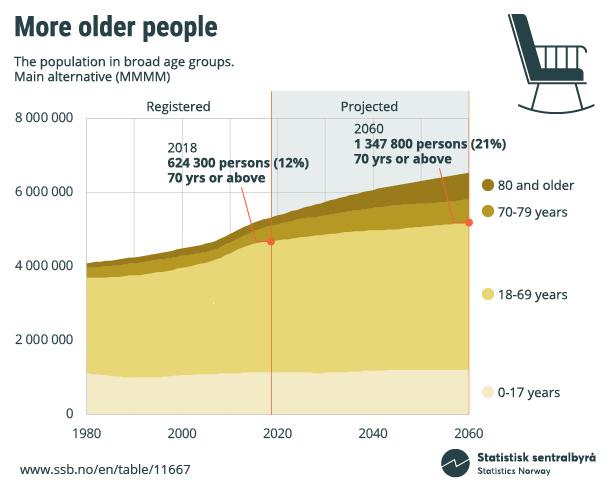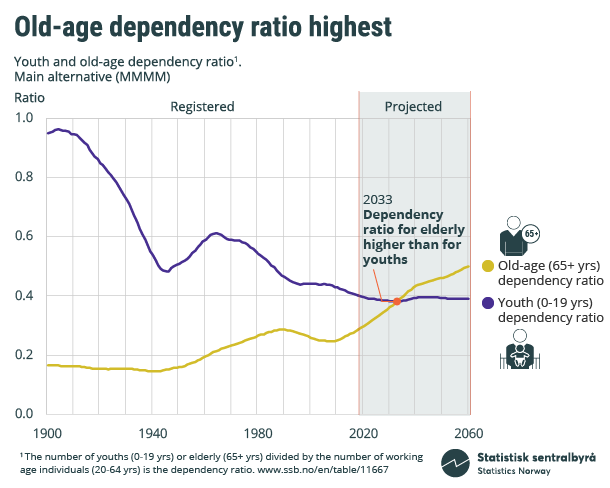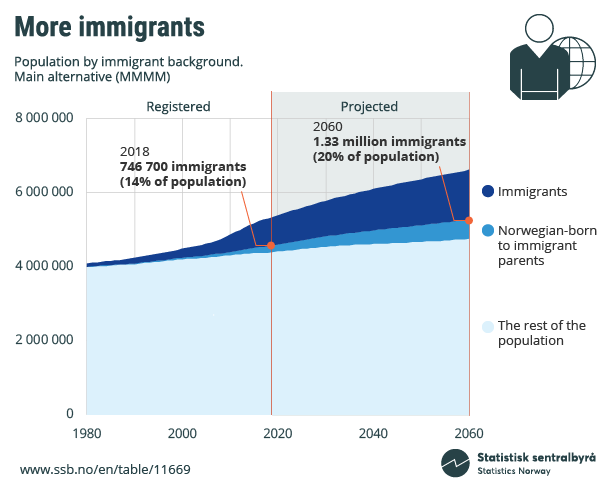Lower population growth in future
Published:
Lower population growth, an ageing rural population and growing numbers of adult and elderly immigrants. These are some of the trends that will impact on the future population, according to the 2018 population projections.
- Full set of figures
- National population projections
- Series archive
- Population projections (archive)
In recent decades, the population in Norway has grown considerably due to high net migration, relatively high fertility rates and a drop in the number of people at an age where mortality rates are high. Population growth peaked in 2011 and 2012, but has since fallen markedly. In the main alternative of the population projections, population growth levels out over the next ten years, before sinking again. However, the growth will be positive throughout this century in the main alternative, and by 2040 there will be 6 million inhabitants in Norway. The current population stands at 5.3 million.
Statistics Norway projects the population in the municipalities up to 2040. At the national level, figures up to 2100 are published, with a focus on the period 2018–2060.
Assumptions determine projections
In the population projections, several different alternatives are produced for future population developments in Norway. The main alternative (MMMM) reflects a medium development in fertility, life expectancy, internal migration and immigration. Specifically, this entails the following:
• fertility continues to fall to just below 1.60 children per woman in the short term, before gradually rising to a long-term level of 1.76
• life expectancy increases by more than seven years for men and six years for women by 2060
• the internal migration pattern we have seen over the last ten years continues
• net migration in the long term will be almost 20 000.
We also produce other alternatives with other assumptions. Population growth is far higher in the HHMH alternative, which assumes high fertility, high life expectancy, medium internal migration and high immigration. In the LLML alternative, with low fertility, low life expectancy, medium internal migration and low immigration, the population continues to increase for a few decades, but by 2060, the population in Norway starts to decline. The alternatives for strong and weak ageing (LHML and HLMH) show how dissimilar the age structure may become depending on the combination of the various alternatives of the assumptions.
The fact that the estimates differ between the different alternatives shows the impact of the assumptions. Assumptions for immigration are associated with the most uncertainty, but developments can also vary somewhat from the assumptions for fertility, life expectancy, internal migration and emigration. The uncertainty in the population projections increases the further ahead we look. The figures are particularly uncertain when examining small groups, such as the population in municipalities by sex and one-year age groups.
The main reason why the growth in the main alternative (MMMM) is lower than we have seen in the last decade is that immigration has fallen and is expected to continue at a lower level than in the last decade. In addition, the fertility has fallen considerably. We expect it to increase somewhat after initially remaining low for a few years, but it is not expected to be as high as ten years ago.
Strong growth in central areas
The growth in the population is primarily in central areas, while in many rural municipalities the population is declining. This is linked to the assumption that internal migration patterns seen in the last ten years will continue. Thus, our projections show continued centralisation, particularly among young adults.
The towns and cities will continue to grow in the main alternative of the population projections (MMMM). Oslo has a projected growth of around 140 000 up to 2040, and will reach 700 000 within five years and 800 000 in about 20 years. The model results also indicate that Bergen will reach 300 000 within 15 years, Trondheim 200 000 within five years and Kristiansand 100 000 in about ten years.
Clear ageing
The proportion of elderly people in the Norwegian population is steadily growing, but the trend is not as strong as in some other European countries. In the main alternative, the proportion of the population aged 70 and over increases from the current 12 per cent to 21 per cent in 2060. One in five inhabitants will thus have reached the age of 70. The increase is particularly strong among those aged 80 and over. Additionally, because of the population growth, we will see more than a threefold increase in the number aged 80 and over.
The ageing population is most clearly evident in rural areas, and migration patterns reinforce ageing in two ways: young people of childbearing age move to towns and cities, and any children they have are also therefore more likely to be born in central areas. The elderly remain in rural areas, and by 2040 more than one in three inhabitants in some rural municipalities will be age 70 or above.
Ageing has consequences for what is referred to as the inverse dependency ratio, which is an indication of how many people are of working age relative to the number of elderly and/or children and adolescents. Today, the ratio is more than 3:1, but by 2060 the ratio will fall to 2:1.
In fifteen years, there will be more elderly people than children and adolescents in Norway for the first time ever. This also means that the old-age dependency ratio (65 years or more) will be higher than the dependency ratio for children and adolescents (0–19 years).
More elderly immigrants
The number of immigrants in Norway is also expected to increase. Today, around 750 000 of inhabitants in Norway are immigrants, and this figure will reach 1.3 million by 2060, according to the main alternative. Growth among immigrants is not expected in the younger age groups, but we will see a sharp increase in immigrants over the age of 40. The number of immigrants in the oldest age group will also increase. Today, immigrants account for less than 5 per cent of the over 70s in Norway, but in the main alternative this increases to 24 per cent by 2060. This means that one in four of the over 70s in Norway will be an immigrant.
Excess of births and net migration
In recent decades, net migration has been the main contributor to the strong population growth in Norway. The excess of births has remained more stable at around 15–20 000 per year. In the main alternative (MMMM), both the net migration and the excess of births contribute to future population growth at a stable rate up to 2030. The excess of births then falls, primarily because the large post-war cohorts have reached an age when it is more common to die, pushing up the overall number of deaths.
Lower than last projections
Compared with the previous projection, which was published in June 2016, the projected population in the main alternative is somewhat lower this time. This is due to lower assumptions about future immigration and fertility (in the short term), and because the population in Norway is now lower than we thought it would be when we published the previous population projection.
More details in separate report
Detailed results from the projection, including population by age and sex for all municipalities up to 2040 and for Norway as a whole up to 2100, are available in StatBank. Figures from earlier projections are also available. The projected demographic trends for Norway are also illustrated in a mapping program (in Norwegian).
The results from the population projections, as well as the methods and assumptions used, are discussed in more detail in a separate report.
Contact
-
Queries about the projections
-
Marianne Tønnessen
-
Statistics Norway's Information Centre



